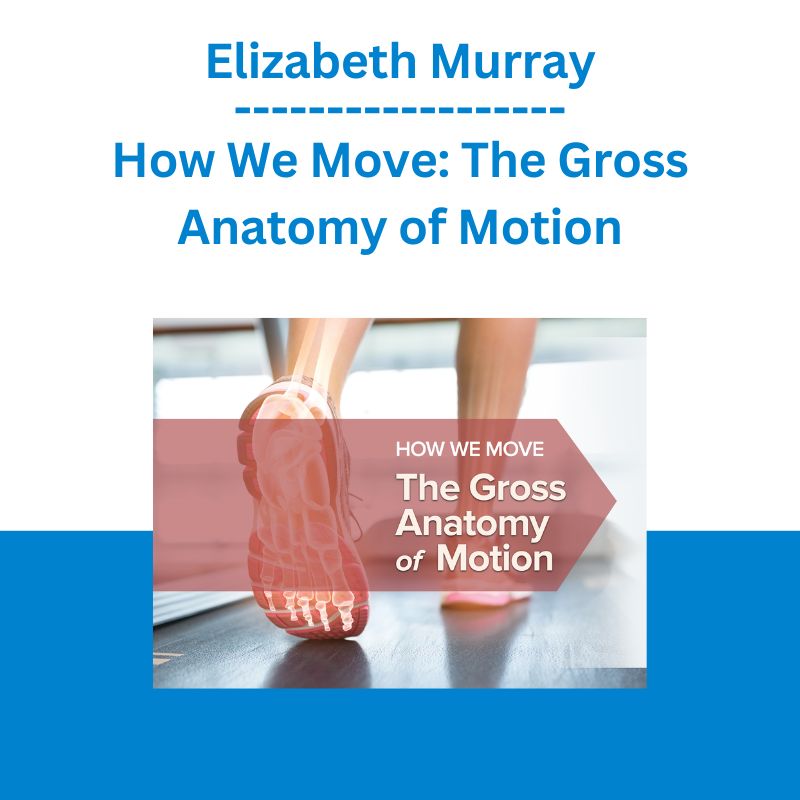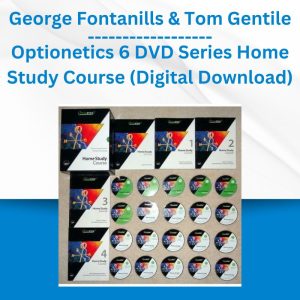*** Proof of Product ***
Exploring the Essential Features of “Elizabeth Murray – How We Move: The Gross Anatomy of Motion”
How We Move: The Gross Anatomy of Motion
Discover the structures and systems of human locomotion as you explore the gross anatomy of movement with guidance from an award-winning professor.
LECTURE
Trailer
01:The Essential Language of Anatomy
Welcome to the unique language of the body, where you’ll learn the words that anatomists use to identify body parts, in both precise and relative terms. Starting from the standard anatomical position, you’ll learn the vocabulary of directionality within the body and the history of its standardization over the centuries.
34 min
02:Bones as the Body’s Framework of Movement
Begin to explore the fascinating skeleton of the human body, the bones of the leverage systems that cause our movements. But did bones evolve for the purpose of moving an organism along? Or might bones have evolved as a response to a completely different need—One you might never have considered?
31 min
03:Joints: Structure Determines Function
When we consider our anatomical joints, we usually think of movement—the elbow, knee, wrist, etc. But as you’ll discover, our bodies contain many joints that provide only limited movement, and some that do not move at all. As you learn about the ligaments, tendons, cartilage, and bursae that keep us moving, you’ll also discover why some of our joints are only temporary.
33 min
04:The Terminology of Movement Patterns
Explore the six categories of our freely movable synovial joints, the fulcrums of our bodies’ leverage systems. Using a variety of graphic aids, you’ll visualize the joints—from those that allow flat surfaces to simply glide over each other to the ball-and-socket joints that allow movement through all three dimensions.
31 min
05:Muscles as Systems for Motion and Support
Explore the three types of muscle tissue that move our bodies, whether voluntarily or involuntarily. Learn the major functions of skeletal muscle, which not only moves our skeletal system, also keeps it still and stable, provides as much as 85% of our normal body heat, and regulates glycemic control.
30 min
06:The Role of the Nervous System in Movement
Begin to examine two of the primary divisions of the nervous system, the central and peripheral. Learn about the cranial nerves that govern functions in the head and neck and the spinal nerves that control skeletal muscles and receive sensations from the trunk and limbs.
30 min
07:The Spine: Fundamentals of the Body’s Axis
The body’s axial skeleton consists of the skull, ribs, sternum, spine, and one of the most unusual bones of the body—the hyoid. Look closely at the spine and the bones that support the overall structure of the body and consider the ways such an important system can be affected by pain and injury.
31 min
08:The Skeleton of the Head and Torso
When we think of our body’s joints, we tend to imagine our most mobile joints—the elbow or shoulder for example. But our skull has 22 bones, all united by joints. Learn about these synarthrotic suture joints and the subtle differences between male and female skulls. Examine the sternum, consider the formation of the ribcage, and learn the difference between true and false ribs.
30 min
09:The Many Muscles of the Head and Neck
Discover the fascinating musculature of the face, muscles we rarely think about, but which allow us to communicate our most subtle emotions. Learn about muscles of the neck that direct our head movements. Examine the functions of some of our 12 pairs of cranial nerves and how they relate to muscles and sensations of the head and neck.
30 min
10:Back Muscles: Layering and Movements
Explore the muscles of the back in all their layered complexity. Learn which muscles “live” on the back but are actually muscles of the upper limbs, which stabilize and move the spine. And learn which paper-thin muscles aid in respiration … or do they?
32 min
11:Torso Muscles: Thoracic, Abdominal, and Pelvic
Explore the musculature of the torso—the thoracic, abdominal, and pelvic muscles, which aid bodily functions like breathing. Learn about the fascinating properties of the respiratory diaphragm, the only skeletal muscle that is both voluntary and programmed for rhythmic contraction and relaxation.
33 min
12:Digital Cadaver Lesson: Head, Neck, and Torso
While scientists have been examining cadavers for at least the past two millennia, anatomists today have the extraordinary tool of “Anatomage,” often called a digital autopsy table. Learn how this tool came about as you explore the bones and muscles of the spine, head, and torso—removing one layer at a time, to see what lies beneath.
32 min
13:The Brachial Plexus of the Upper Limb
Examine the brachial plexus, the network of nerves that relays signals from the spinal cord to the upper limb and that takes almost all sensations of that region to the central nervous system for processing. More complex than any other plexus of the somatic nervous system, its work is integral to our day-to-day living.
31 min
14:The Shoulder: Mobility versus Stability
Explore the strengths and weaknesses of the human shoulder and the relationship of that joint to the anatomy of past primates who spent their lives swinging in the trees. Learn about the many bones and muscles that make up this complex and most mobile joint, and some of the ways in which it’s commonly injured.
32 min
15:Shoulder to Elbow: The Anatomical Arm
Explore the bones, muscles, and ligaments of the elbow, a complex region actually made up of three separate joints. Learn about the fascia of the arm and the cutaneous veins that provide the extra blood you can access in an emergency—whether encountering a predator or starting up your workout.
32 min
16:The Complexity of the Forearm and Wrist
Learn about our nearly 20 forearm muscles that cause wrist and finger movements, as well as the remarkable actions of our thumb. The ability to oppose the thumb with other digits in a grasping motion is one of the hallmarks of our primate lineage. The forearm is also home to muscles that allow us to turn our palms to face up or down, an action which actually occurs at the elbow.
34 min
17:The Hand and How It Works
Explore the architecture of the human hand, one of the most significant anatomical features that separates us from almost all other animal life. It’s that fine motor coordination along with our bipedalism that has allowed us to become the species we are today. You’ll also learn about the source of carpal tunnel pain and how surgery may help relieve it.
32 min
18:Digital Cadaver Lesson: The Upper Limb
Using “Anatomage” digital technology with the ability to see beneath the skin, you’ll examine the 30 bones of the upper extremity, as well as the intricacy of the shoulder, elbow, wrist, and hand joints. You’ll also be able to visualize the muscles of the shoulder, including the group known as the rotator cuff, in addition to the many other muscles of the arm, forearm, and hand.
23 min
19:Nerve Plexuses of the Lower Limb
Explore the lumbar and sacral plexuses, those networks of interconnected nerves that control the muscles of the lower extremity and pelvic floor and that relay sensations from the lower limbs and genitalia. As part of the sacral plexus, you’ll learn about the sciatic nerve, the largest and longest nerve in the body.
33 min
20:The Multiplex Pelvis and Its Hip Joint
While the childhood hip bones are three separate bony elements with cartilaginous growth regions, the three regions are united into one single bone once the cartilage has ossified. The pelvis is a complex of the two hip bones as well as the sacrum and coccyx. Explore the multi-axial hip joints and the pelvis, where differences between the female and male skeleton are most obvious.
32 min
21:The Thigh: Our Largest Bone and Its Muscles
Continue your examination of the lower limbs with the femur, the body’s largest and strongest bone. You’ll learn about the muscles of the thigh and visualize their origins and insertions. Explore the quads and hamstring muscles and how they work to provide hip and knee mobility, and learn about the patella, your kneecap.
32 min
22:Knee to Ankle: The Anatomical Leg
Continue the exploration of the knee joint, one of the most complex joints in the body. Examine the multiple bones and ligaments that allow for both movement of this hinge joint as well as stability. Learn about the ACL and why a tear in the meniscus takes so long to heal. Get to know the three muscle compartments that lie between the knee and ankle.
34 min
23:The Features of Our Complicated Feet
Although we think of our hands as being the most intricate and complex parts of our limbs, our feet have a few more intrinsic muscles than our hands. Explore the complexities of the bones, muscles, and tendons within the feet—which support not only our own weight, but also anything we pick up to carry.
32 min
24:Digital Cadaver Lesson: The Lower Limb
The complex musculature of the feet is easy to visualize with the “Anatomage” digital system; so are the muscles of the hip, thigh, and leg. You’ll see the muscles peeled back, layer by thin layer, and you’ll develop a better understanding of the role played by ligaments in stabilizing these “pedestals.” You’ll also explore the bones and joints of the lower limb from numerous angles.
29 min
DETAILS
Overview
In How We Move: The Gross Anatomy of Motion, you’ll look inside the human body as never before, discovering your gross anatomy, the parts of the body that can be seen with the unaided eye, your macroscopic body. You will view graphics, photos, videos, and the digital autopsy table called “Anatomage,” to help your understanding of the topics covered. Professor Elizabeth A. Murray takes you on a 24-lecture journey through the major regions of the body in all their complex grandeur. It’s safe to say that you’ve never seen anything like this!
About
Elizabeth A. Murray
With nearly 30 years in the field, I guess I was ‘forensic’ before it was cool! I find forensic science to be a fascinating subject that incorporates law, ethics, psychology, history, and technology, as it aids our global community.
Dr. Elizabeth A. Murray is a forensic anthropologist and also Professor of Biology at Mount St. Joseph University, where she teaches doctoral-level human gross anatomy and undergraduate-level anatomy and physiology, as well as forensic science. She earned her bachelor’s degree in biology from Mount St. Joseph University and her master’s degree in anthropology and Ph.D. in Interdisciplinary Studies in Human Biology from the University of Cincinnati.
Most of Professor Murray’s forensic casework has been in Ohio and Kentucky, where she has participated in hundreds of investigations. She is one of fewer than 100 anthropologists certified as a Diplomate by the American Board of Forensic Anthropology. Professor Murray has been honored with the Sears-Roebuck Foundation Teaching Excellence and Campus Leadership Award, and she twice earned the Clifford Excellence in Teaching Award. She has served as an instructor for numerous organizations, including the U.S. Department of Justice, the Armed Forces Institute of Pathology, and the International Association of Coroners & Medical Examiners. Her television appearances include National Geographic’s Buried Secrets, Discovery Health’s Skeleton Stories, The New Detectives, and Forensic Files. Her book Death: Corpses, Cadavers, and Other Grave Matters was named one of the top ten summer titles for students by the American Association for the Advancement of Science. Her 2012 book, Forensic Identification: Putting a Name and Face on Death, was selected as one of the outstanding books of 2012 by the prestigious National Science Teacher’s Association.
REVIEWS
fun old man
Sebring, FL
Extraordinary; Concise; Informative
Bought the course to expand my understanding of personal issues as well as learn more biology. This course is well paced, complete, and provides all anyone studying gross anatomy could want in 24 lectures. Truly a gift. Hope this instructor will author more great course in the future.
Please see the full list of alternative group-buy courses available here: https://lunacourse.com/shop/










 Matthew Kratter - Trader University
Matthew Kratter - Trader University  Greg Loehr - Advanced Option Trading With Broken Wing Butterflies
Greg Loehr - Advanced Option Trading With Broken Wing Butterflies